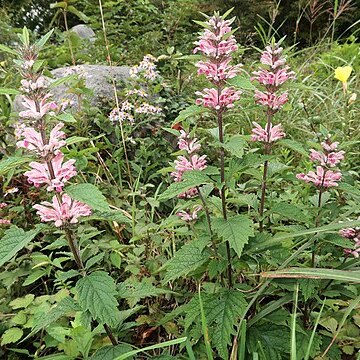Plants perennial. Rhizomes woody. Stem erect, 60-120 cm, solitary, appressed retrorse strigose. Petiole of basal leaves ca. 2 cm; lower stem leaf blades cordate-orbicular, 7-12 × 6-9 cm, 3-lobed, sparsely minutely hispid, base cordate, margin incised, apex acute; mid stem leaves ovate. Verticillasters sessile, 8-12-flowered; floral leaves reduced, ovate to ovate-lanceolate, margin irregularly incised to subentire, apex long acuminate; bracteoles spiny, ca. 7 cm, hispid. Flowers subsessile. Calyx tubular-campanulate, 7-9 mm, strigose, with spinescent teeth, veins conspicuously elevated; anterior teeth subulate-triangular, ca. 1 cm; posterior teeth triangular, ca. 5 mm. Corolla reddish or reddish purple, 2.5-2.8 cm, densely pubescent, scaly annulate inside, scaly near lower lip; tube gradually dilated at apex, ca. 1/2 as long as corolla; upper lip straight, oblong, concave, ca. 12 × 5 mm, margin entire; lower lip ca. 8 × 5 mm, middle lobe ca. 2 × as long as ovate lateral lobes, obcordate, conspicuously emarginate. Nutlets black-brown, oblong, triquetrous, ca. 2.5 mm, base cuneate, apex truncate. Fl. Jul-Sep, fr. Sep.
More
A herb which keeps growing from year to year. The underground stems are woody. The stem is erect and 60-120 cm high. There is just one stem. The leaf stalk of the leaves near the base is about 2 cm long. The blades are heart shaped or rounded and 7-12 cm long by 6-9 cm wide. They have 3 lobes. The base is heart shaped. The edges of the leaf are incised. There are 8-12 flowers. They are red to purple. The nutlets are black to brown. They are oblong and 3 sided.
Grassy places and thickets in hills all over Japan. Grows in shady places in Kiangnan, China. Grassy slopes and thickets to 400 metres in Hebei, Jilin and Liaoning.
More
It is a temperate plant. In China it grows on grassy slopes up to 400 m altitude in northern regions.

